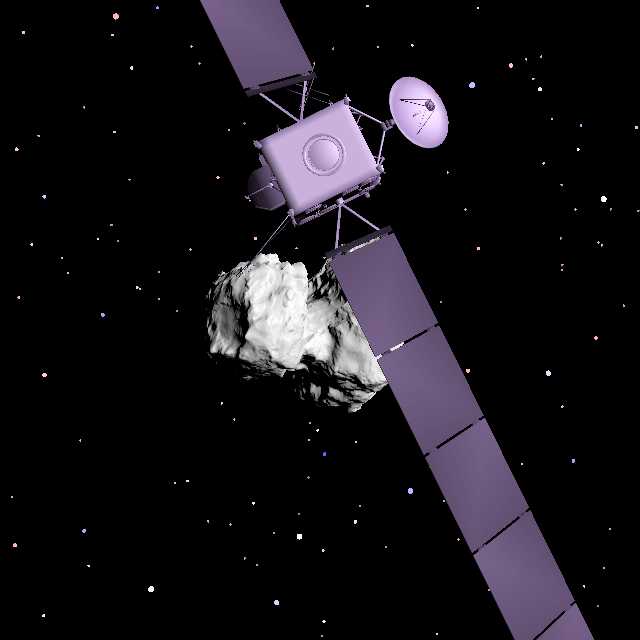You are here : OVSQENObservationSatellite observationsROSETTA
- Partager cette page :
- PDF version
The ROSETTA Mission
The ROSETTA mission is a mission of the European Space Agency (ESA) whose objective is the study of comet 67P / Churyumov-Gerasimenko.
Conduct of the mission
The mission was launched on 2nd March 2004 from the Kourou base by an Ariane 5 launcher. During its journey towards the comet, the probe flew over and auscultated two asteroids: Steins and Lutetia. In order to save energy, the probe was then placed in hibernation on 8th June 2011. As it approached the sun, it woke up as expected on 20th January 2014. As of May 2014, the orbiter began to observe the nucleus of the comet and its environment. An observation phase followed where it got closer and closer with the intention of determining the landing site for the Philae module. On 12th November 2014, the Philae lander touched down on the surface of the comet (after a few bounces!). For 3 days, it gathered data before shutting down for lack of power. It is possible that Philae will wake up before the comet reaches its perihelion, that is to say at its closest point to the Sun, in August 2015. [1] The orbiter continued to escort the nucleus until its fuel was exhausted.
More details here: http://www.esa.int/fre/ESA_in_your_country/France/Rosetta
Instruments
LATMOS is involved in seven experiments on board the Philae orbiter and lander.On the orbiter:
- OSIRIS: two high-resolution optical cameras designed to carry out a topographic survey of the nucleus with a resolution of about 1 m, to determine the rotation of the nucleus, to observe its degassing and to follow dust and gas jets.
- ALICE: a UV imaging spectrometer designed to analyse the composition of the coma, the tail and the production of water as well as carbon monoxide and carbon dioxide from the nucleus.
- ROSINA: a spectrometer for noble and ionised gases designed to determine the composition of the atmosphere and the ionosphere of the comet, the chemical reactions that take place there as well as the speed of the ionised gas particles and to follow dust and jets gas.
- MIDAS: an atomic force microscope designed to study the size, shape and volume of particles around the comet.
- CONSERT (also on the lander): a radio frequency radar sounder designed to study the internal structure of the nucleus.
- COSAC: a gas chromatograph coupled with a mass spectrometer designed to analyse gases and complex organic molecules in samples taken from the ground and from the subsoil.
- PP-SESAME: a permittivity probe designed to determine the very low frequency complex electrical permittivity of the near surface of the comet’s nucleus and to study its variations over time.


